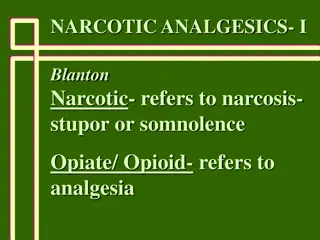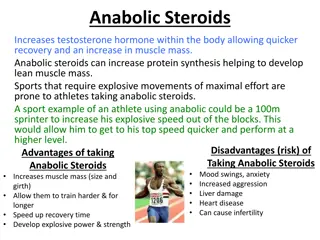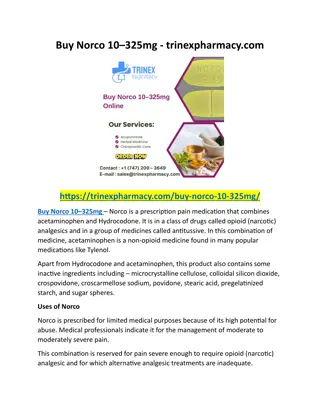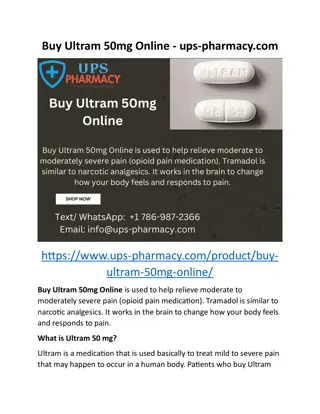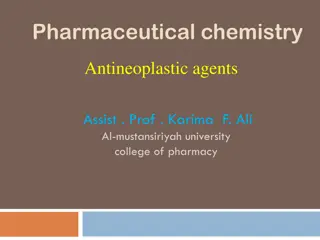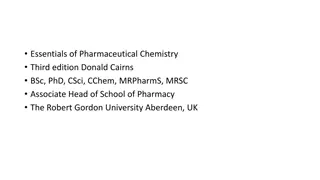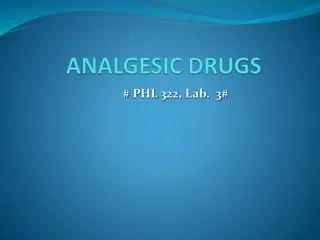Pharmaceutical Chemistry Analgesic Agents Narcotic Analgesics
Analgesic agents play a crucial role in managing pain, ranging from mild to severe, with different categories such as opioids, NSAIDs, and triptans. The origin of pain can vary from physiological to neuropathic causes. Opioids target opioid receptors, with discoveries in endogenous ligands like enkephalins. Structure-activity relationships of enkephalins have shown preferences for specific amino acids. Understanding these aspects is essential in pharmaceutical chemistry for developing effective pain relief medications.
Download Presentation

Please find below an Image/Link to download the presentation.
The content on the website is provided AS IS for your information and personal use only. It may not be sold, licensed, or shared on other websites without obtaining consent from the author. Download presentation by click this link. If you encounter any issues during the download, it is possible that the publisher has removed the file from their server.
E N D
Presentation Transcript
Pharmaceutical Chemistry Analgesic Agents Narcotic Analgesics e
Analgesics 1. The opioids (or narcotic analgesics), which play a major role in the relief of acute pain and in the management of moderate to severe chronic pain; 2. The NSAIDs and acetaminophen, which are the most widely used analgesic drugs for relieving mild to moderate pain and reducing fever; 3. The triptans (the antimigraine medications), which are specifically designed and targeted for acute and abortive treatment of migraine and cluster headaches 4. Analgesic adjuvants that include tricyclic antidepressants such as amitriptyline, anticonvulsants such as gabapentin and pregabalin, and topical analgesics such as lidocaine patches that can be used to treat neuropathic pains.
Origin of Pain Physiological (nociceptive): is the most common and is often caused by an injury to body organs or tissues. It is further categorized, according to the source of the pain, into cutaneous pains (skin and surface tissues), somatic pains (ligaments, tendons, bones, blood vessels), and visceral pains (body organs and internal cavities). Inflammatory: originates from an infection or inflammation as a result of the initial tissue or organ damage. Neuropathic: Neuropathic pain is a very complex, chronic pain, resulting from injury of the nervous systems.
Opioids Opioid Receptor Discovery and Endogenous Ligands: The first endogenous peptide was termed enkephalin, which was found to be a mixture of the two pentapeptides that only differ in their terminal amino acid (Met-enkephalin) and (Leu- enkephalin). The transient nature of the enkephalins actions correlated with the rapid degradation of the enkephalin Tyr-Gly bond by aminopeptidases. Much synthetic work has been done in an attempt to increase the duration of action of the opioid peptides and maintain their analgesic effect.
SARs of Enkephalins The first amino acid of the pentapeptide shows a distinct preference for tyrosine. Most changes to this amino acid, either by substituting with other amino acids or masking the phenolic hydroxyl (OH) or amino function, produce an inactive or weakly active peptide.
GLY2 Replacing the naturally occurring L-Gly with various D- amino acids produces a peptide that is resistant to peptide cleavage by aminopeptidases. Replacement with D-Ser is the most effective replacement, and all L-amino acid analogs had low activities. Substituting D-amino acids for L-amino acids produces stable peptides, and the stereochemical change may give the peptide access to additional binding sites on the receptors Replacing the Gly2 with D-Ala2 while simultaneously replacing the L-Leu5 with D-Leu5 produces the peptide known as D-Ala2, D-Leu5 enkephalin (DADLE), which is commonly used as a selective -agonist
Gly3 Almost all changes to this amino acid result in a drop in potency, unless they are also accompanied by another change such as replacing the Gly2 with D-Ala2 . Phe4 The aromatic nature of the fourth residue is required for high activity. When combined with the D-Ala2 replacement, the addition of an electron withdrawing, lipophilic substituent (e.g., NO2, Cl, and Br) in the para position of Phe4 greatly increases activity. Para substitutions with electron donating, hydrophilic functional groups (e.g., NH2 and OH) abolish activity. Met5/leu5 Position 5 appears to tolerate more residue changes than the other positions. Many amino acid substitutions at this position maintain activity (e.g., Ala, Gly, Phe, Pro).
The pituitary gland, hypothalamus, and the adrenal medulla all produce various opioid peptides. Many of these materials were found to be fragments of lipotropin ( - LPT) a 91 amino acid peptide. The fraction containing amino acids 61 91 is designated - endorphin It is much more potent than the enkephalins in both in vivo and in vitro tests. Some examples of endogenous opioid peptides: Endorphin, Endomorphin-1, Endomorphin-2, Dynorphin, - Neoendorphin, - Neoendorphin, Nociceptin, and Orphanin FQ.
Opioid Receptors Opioid receptors are distributed throughout the brain, spinal cord, and peripheral tissues ( , , and k) The -receptor Endogenous peptides for the -receptor include endomorphin- 1, endomorphin-2, and -endorphin. Exogenous agonists for the -receptor include drugs from the five structural classes (4,5-epoxymorphinan, morphinan, benzomorphan, 4-phenyl/4-anilido diphenylheptanes) In general, agonists at the -receptor produce analgesia, respiratory depression, decreased gastrointestinal (GI) motility, euphoria, feeding, and the release of hormones. Agonists are also responsible for the addictive effects of the opioid analgesics. Most clinically used opioid drugs bind to the -opioid receptor. piperidines, and the
The -receptor Opioid peptides for the -receptor include the endogenous peptides described previously, Met and Leu enkephalin, as well as some synthetic peptides such as DADLE, DSLET, and DPDPE .These peptides have high affinity for the receptor but low bioavailability and thus limited clinical usefulness. The amide nitrogen appears to be the most sensitive to modifications and may play an important role in -receptor selectivity. The address message concept proposes that one part of the molecule may act as an address, essentially directing the chemical to the correct receptor by binding specifically to that receptor, and another part of the molecule acts as the message, which gives the compound the biological action.
The k-receptor Kappa receptors are primarily found in the limbic, brain stem, and spinal cord. TRK-820 is a k-agonist displaying approximately 15 times selectivity toward k-receptors versus -receptors. The 4,5-epoxymorphinan structure of TRK-820 is proposed to mimic the tyrosine glycine moiety of endogenous opioid peptides, in effect the agonist message. The additional 6 -substituent constitutes the address directing the compound to the k-receptor. SARs on this class of compounds revealed that methyl- substituted nitrogen amides, a methylene spacer between the amide and the aromatic ring and the (-) isomer were all required for k- activity.
The orphanin receptor/f q/nop1 The traditional opioid peptides do not elicit any biological effect at the orphanin receptor. An endogenous peptide for the orphanin receptor has been found and termed orphanin FQ or nociceptin . This 17 amino acid peptide can reverse the analgesic effects of morphine thus is antiopioid. This receptor is a target for the design of novel peripherally acting antitussive agents.
Drug classes 1. 4,5-epoxymorphinans: Morphine The prototype ligand for the -receptor is morphine. Morphine contains 5 chiral centers and has 16 optical isomers The naturally occurring, active form of morphine is the levorotatory enantiomorph with the stereochemistry 5(R), 6(S), 9(R), 13(S), and 14 (R).
Morphine was isolated from opium. Opium is isolated from the opium poppy, Papaver somniferum Opium contains over 40 different alkaloids with most alkaloids represented in the following five structures: morphine , codeine , thebaine , papaverine , and noscapine. Morphine is the drug to which all other -agonists are compared, it is used as analgesic agent. The important functional groups for analgesic activity are the phenol OH group, the aromatic ring, and the tertiary amine which is protonated and ionized when the drug interacts with its target binding site. These functional groups play an important role in binding the drug to the binding site by the intermolecular bonding forces
The amine nitrogen is protonated and charged allowing it to form an ionic bond with a negatively charged region of the binding site; The phenol acts as a hydrogen bond donor and forms a hydrogen bond to a hydrogen bond acceptor in the binding site; The rigid structure of morphine means that its aromatic ring has a defined orientation with respect to the rest of the molecule, allowing van der Waals interactions with a suitable hydrophobic location in the binding site.
Morphine: pharmacodynamics and pharmacokinetics Morphine is relatively polar and is poorly absorbed from the gut, and so it is normally given by intravenous injection. The n -methyl quaternary salt of morphine is inactive when it is administered by intravenous injection because it is blocked by the blood brain barrier. If this same compound is injected directly into the brain, however, it has a similar analgesic activity to morphine. If morphine was fully charged, it would not be able to enter the brain either. the amine group is a weak base and so morphine can exist both as the free base and ionized form. This means that morphine can cross the blood brain barrier as the free base then ionize in order to interact with the opioid receptors.
The secondary NH group is more polar than the original tertiary group, and so Normorphine is less efficient at crossing the blood brain barrier, leading to a drop in activity. It is possible to get increased levels of morphine in the brain by using prodrugs where some of the polar functional groups are masked. It is interesting to compare the activities of morphine, 6-acetylmorphine,and diamorphine (heroin) . The most active (and the most dangerous) compound of the three is 6-acetylmorphine, which is four times more active than morphine. Diamorphine is also more active than morphine by a factor of two, but less active than 6-acetylmorphine.
6-Acetylmorphine is less polar than morphine and will cross the blood brain barrier into the CNS more quickly and in greater concentrations. The phenolic group is free and therefore it will interact immediately with the analgesic receptors. Diamorphine has two masked polar groups, and so it is the most efficient compound of the three in crossing the blood brain barrier. Before it can bind to the opioid receptors, however, the 3-acetyl group has to be removed by esterases in the CNS. This means that it is more powerful than morphine because of the ease with which it crosses the blood brain barrier, but less powerful than 6-acetylmorphine because the 3-acetyl group has to be hydrolysed. Diamorphine and 6-acetylmorphine are both more potent analgesics than morphine. Unfortunately, they also have greater side effects, as well as severe tolerance and dependence characteristics. The ability of opioids to cross the blood brain barrier plays an important role in analgesic activity.
Codeine Codeine It is used to a limited extent in cough preparations. Approximately 5% of codeine is metabolized to morphine via O-demethylation. The analgesic component of codeine has long been assumed to be the O- demethylated metabolite, morphine.
It also has no analgesic activity when it is injected directly into the brain. This is not surprising as methylation of the phenol group would be expected to disrupt its ability to act as a binding group What is surprising is the fact that codeine has an analgesic effect which is 20% that of morphine much better than expected. codeine is metabolized by O -demethylation in the liver to give morphine. Thus, codeine can be viewed as a prodrug for morphine.
Heroin Heroin is the 3,6 diacetylated form of morphine. Heroin can pass through the blood-brain barrier quicker than morphine and lead to the euphoric rush .
Hydromorphone: Hydromorphone, is a synthetic derivative of morphine. Reducing the 7,8 double bond of morphine increased the flexibility of the molecule and resulted in a compound with slightly enhanced binding and increased potency (approximately 5 times as potent as morphine).
Hydrocodone The protected 3-position has better brain penetration, and the 7,8-dihydro-6-keto C ring contributes to the increased binding of the compound to the -receptor. It is marketed as an antitussive agent, also marketed in combination with acetaminophen or aspirin for the treatment of pain.
Oxycodone Oxycodone is the 14 beta-hydroxyl version of hydrocodone. This additional functional group gives oxycodone greater potency (1.5 times orally) than hydrocodone presumably by increasing receptor affinity. Oxycodone is marketed in combination with acetaminophen, aspirin, and ibuprofen.
Oxymorphone Oxymorphone is the 14 beta-hydroxyl version of hydromorphone. The addition of the OH group does increase its binding affinity at the receptor.
2. Morphinans The morphinans were made by removing the E ring of morphine ( the 4,5-ether bridge)
Levorphanol: The loss of the 4,5-epoxide and the 7,8-double bond allows levorphanol greater flexibility and leads to the increased binding affinity at all opioid receptors. It is the levorotatory form of methorphan and is approximately 7.5 times more potent than morphine as analgesic agent. Dextromethorphan: It is the dextrorotatory form of levorphanol with a methoxy group on the 3 position. It is available in a lot of OTC cough and cold preparations. Many cases were reported involving abuse of this drug.
3. Benzomorphans Removing the C ring of the morphinan structure, yields the benzomorphans. It is also referred to as the benzazocines Pentazocine The only benzomorphan in clinical use is pentazocine, which is prepared as the 2(R), 6(R), 11(R) enantiomer; it is a mixed agonist/antagonist agent. At the -receptor, pentazocine is a partial agonist and a weak antagonist; it is also an agonist at the k-receptor.
4. (4-Phenyl piperidines and 4-Anilido piperidines) Removal of the B ring of the benzomorphans yields the 4- substituted piperidines. The A ring is in an axial position relative to the piperidine (D) ring, the A ring can exist in either an axial or an equatorial position.
Meperidine: Meperidine is an agonist at the -receptor. The 4-ethyl ester was found to be the optimal length for analgesic potency. Structural changes that increase the potency of meperidine include the introduction of a m-hydroxyl on the phenyl ring, substituting the methyl on the N for a phenylethyl or a p-amino phenylethyl. Meperidine is metabolized to normeperidine by the liver enzymes CYP3A4 and CYP2C18 and in the brain by CYP2B6. Meperidine and normeperidine are also metabolized by liver carboxylesterases.
The use of meperidine should be limited to those patients that have true allergies to the morphine-type opioids, and patients should be monitored for toxicity.
Diphenoxylate: Diphenoxylate is a weak opioid agonist and is available combined with atropine (Lomotil) for use as an antidiarrheal agent.
Loperamide: Loperamide (Imodium) is a 4-phenylypiperidine with a methadone-like structure attached to the piperidine nitrogen. It acts as an antidiarrheal by directly binding to the opiate receptors in the gut wall.
4-Anilidopiperidines: When the 4-phenyl substituent of meperidine was replaced with a 4-aniline with a nitrogen connection, the potency increased. This led to the development of the 4-anilidopiperidine series of compounds (fentanyl, alfentanil, sufentanil, remifentanil).
Fentanyl was the first compound marketed . The high lipophilicity of fentanyl gave it a quick onset, and the quick metabolism led to a short duration of action. The combination of potency, quick onset, and quick recovery led to the use of fentanyl as an adjunct anesthetic. The SAR studies of the 4-phenylpiperidine analgesics found that the propionamide is the optimal chain length. Adding polar groups to the 4-piperidine carbon (CH2OCH3 in sufentanil and alfentanil, COOCH3 in remifentanil) increases potency. The piperidine nitrogen of fentanyl contains a phenethyl substituent that appears to be the correct chain length for optimal potency.
Fentanyl and its analogues represent a class of opioids known as the 4-anilinopiperidines and are among the most potent agonists known for the receptor. These drugs lack a phenolic group and are very lipophilic. As a result, they can cross the blood brain barrier more efficiently. Fentanyl itself is up to 100 times more active than morphine as a sedative and analgesic
5. Diphenylheptanes Methadone Methadone is a synthetic opioid approved for analgesic therapy and for the maintenance and treatment of opioid addiction. Methadone is marketed as the racemate, although the opioid activity resides in the R-enantiomer (7 50 times more potent than the S-enantiomer). Methadone is a -receptor agonist.
Propoxyphene Propoxyphene is a derivative of methadone . It is only about 1/10th as potent as morphine as an analgesic yet retains all the same opioid adverse effects.
Miscellaneous Tramadol Tramadol is an analgesic agent. It is a weak -agonist. Structurally, tramadol resembles codeine with the B, D, and E ring removed. Tramadol is synthesized and marketed as the racemic mixture of two (the [2S, 3S] [-] and the [2R, 3R] [+]) of the four possible enantiomers. The (+) enantiomer is about 30 times more potent than the (-) enantiomer.
Opioid Antagonists Naltrexone: Naltrexone is a pure opioid antagonist at all opioid receptor subtypes with the highest affinity for the -receptor. Theoretically, it should work well to treat opioid dependence but in clinical practice, patients have shown poor compliance and high relapse rates. Naltrexone has also been studied to treat alcohol dependence with mixed results. Naloxone: Naloxone is a pure antagonist at all opioid receptor subtypes. Structurally, it resembles oxymorphone except that the methyl group on the nitrogen is replaced by an allyl group. It is used to reverse the respiratory depressant effects of opioid overdoses.
Nalmefene: It is a pure opioid antagonist that is the 6-methylene analog of naltrexone. It is available to reverse the effects of opioids after general anesthesia and in the treatment of overdose. Methyl naltrexone: It is the methylated, quaternary form of naltrexone. The permanently charged nitrogen prevents the drug from crossing the blood-brain barrier. Thus, it only acts as an antagonist at peripheral opioid receptors.
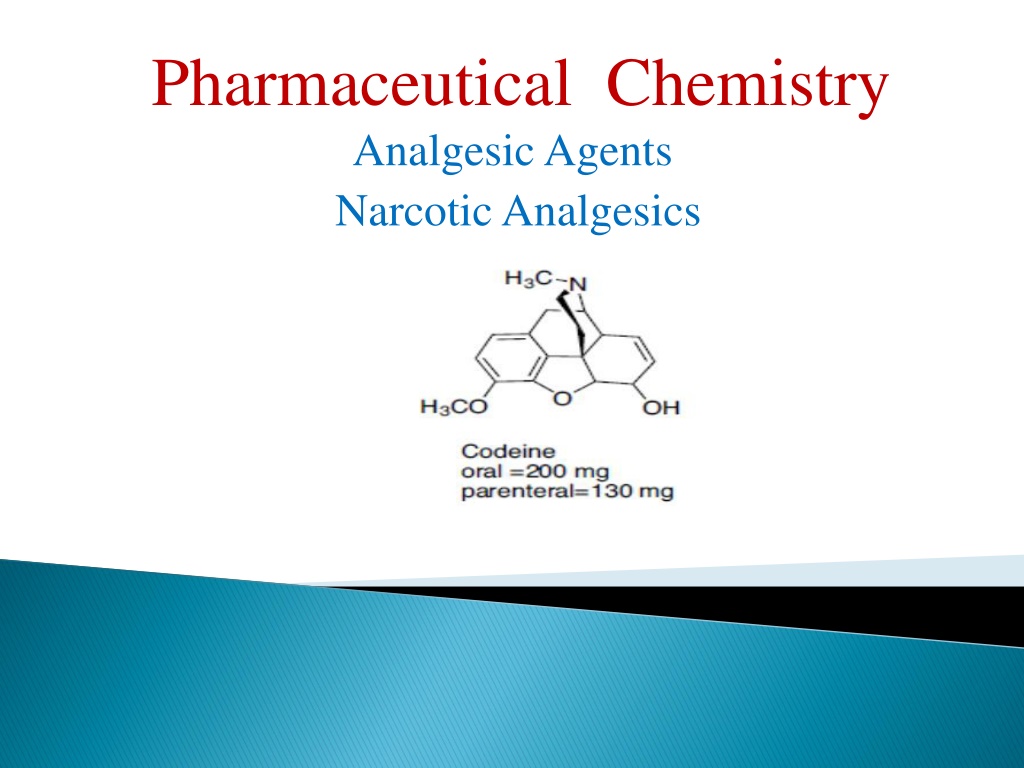
 undefined
undefined










